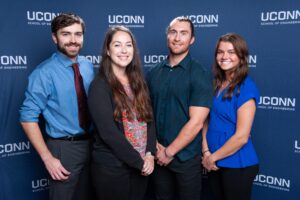- Homepage
- >
- Senior Design Day 2022
Senior Design Day 2022
Senior Design Demo Day took place on April 29, 2022 in Gampel Pavillion. Students across all engineering departments joined together to showcase all of their hard work this year. There were 21 Civil Engineering projects and 9 Environmental Engineering projects in the event. Everyone should be proud of how far they have come since their first week of college.
Congratulations to all of the graduating seniors and to the following Senior Design Project winners this year:
Civil Engineering
Modern Roundabout at the Intersection of Hunting Lodge Road and North Eagleville Road
First Place


Team Members: Kaitlyn Kondos, Nicole Martocchio, Joseph Mikulewicz, Avishan Montazer (Faculty Advisor: Shinae Jang)
Working alongside Vanasse Hangen Brustlin, Inc. (VHB), Team CE10 was assigned to investigate improvements to the University of Connecticut’s traffic flow and campus safety. Specifically, the team evaluated the campus gateway of the intersection of Hunting Lodge Road and North Eagleville Road. After preliminary traffic flow and site condition analysis, Team CE10 evaluated three potential options for intersection improvement: a modern single-lane roundabout, traffic signalization, and pedestrian/cyclist improvements. Team CE10 ultimately came to the conclusion that the modern single-lane roundabout would be the most successful and cost-effective solution to traffic congestion and safety concerns. With the help of VHB, Team CE10 drafted a roundabout design for this intersection. Through thorough research, CE10 chose the most cost-effective and reliable options. Based on material prices with the ongoing supply chain challenges, the team assembled a thorough cost estimate. The final product consists of a finished set of drawing plans alongside a detailed cost estimate.
Design of Site Work for the Reconstruction of Washington Elementary School, West Haven, CT
Second Place


Team Members: Fiona Casey, Aidan Fay, Katie Laresch, Meg Sirowich (Faculty Advisor: Philip J. Katz, P.E. , Manish Roy)
Washington Elementary School in West Haven, Connecticut has not had a major renovation in over thirty years. Recently, plans have been made to reconstruct the building to meet code requirements and create a better educational environment for the students. Civil Engineering Senior Design Group 20’s role in this project was to work with STANTEC Consulting Services INC. to design a new site plan for the new building using AutoCAD. The current site has a small parking lot and a route for student drop-off and pick-up that often gets crowded with parental and faculty/staff vehicles, and school buses. The group’s design better utilizes all the space available on the site to create efficient parking and drop off areas along with two new playgrounds for the students. The plans for the site included site gradation, drainage, and sediment and erosion control. A materials cost analysis report was also prepared.
Design of the Extension of Constitution Boulevard West in Shelton, CT
Third Place


Team Members: Jacob Zakrzewicz, Brad Kelle, Samuel Baum (Faculty Advisor: Terrance Gallagher, PE, Ronald J. Nault, PE, Manish Roy)
Senior Design Team 21 was tasked with designing the extension of an existing roadway through woodland to allow vehicular access to a large, City-owned property in Shelton, CT. This development has been a consistent top priority within the City’s Plan of Conservation and Development to allow for industrial economic growth in a healthy mix within existing residential, light commercial, and open space land uses. Shelton has already developed connections with companies interested in constructing buildings on this land. Addressing project feasibility, Shelton divided this road extension project into two phases. This project’s scope is defined by Phase 1 which extends the western end of Constitution Boulevard South from where it currently terminates at Bridgeport Ave. to terminate in a cul-de-sac approx. 3100ft into the woodland. The City of Shelton expects this completed roadway to stimulate economic development and increase public access to open land. Phase 2 will increase mobility and safety of commuting traffic by connecting Phase 1 to the existing intersection with Rt. 108. The design process began with evaluation of existing conditions using publicly available data and hand calculations. Local ecology, current land use, and topography were evaluated through the use of ArcGIS Pro and OpenRoads. Hand calculations established the pre-development water runoff, infiltration, and storage. These approximations informed results derived using HydroCAD. Through the combined visualization of a 3-D terrain model, existing wildlife habitats, land use, wetlands, and property boundaries, three roadway alignment and profile proposal alternatives were developed. Each alternative was evaluated to determine the most cost-effective road design that minimizes environmental impacts, rock cut and fill requirements, and allows for future economic development that will not negatively impact water quality for the local community and regional ecology.
Environmental Engineering
Centredale Manor Restoration
First Place

Team Members: Scott Ackerman, Taryn Shannon, Andrew Macklin, Madeleine Hasson (Faculty Advisor: Alexander Agrios)
The Centredale Manor Restoration Project (CMRP), located North Providence, RI, has been assigned a mandated clean-up under the Comprehensive Environmental Response, Compensation, and Liability Act (CERCLA). Loureiro Engineering has been tasked to excavate and dispose of any sediment and floodplain soils that are contaminated above regulated levels. Environmental Engineering Team 4 has been tasked with designing a plan for remediation and restoration of the Oxbow wetland area and adjacent floodplain within the CMRP. Due to manufacturing pursuits along the river in the 19th century by Woolen Mill, Metro-Atlantic Inc., and the New England Container Company Inc., there is chemical residue remaining along the river, in groundwater, and in the soil on the site. Along the Woonasquatucket River and Oxbow area there are residential areas, businesses, and a Little League baseball field that are at risk from the contaminants of concern located on site. The main contaminants being looked at are dioxins and furans. The excavation plan was modeled based on the level of themost toxic dioxin, 2,3,7,8 TCDD that, in many areas, is beyond the alternative treatment standard of 10 μg/kg set by the EPA. In addition to the excavation plan, ENVE 4 also created a restoration plan for the wetland. The wetland currently consists of 4 major habitats: upland forest, palustrine forested, palustrine shrub-scrub, and palustrine emergent. The plan was designed to return the wetland to its original construction. The restoration plan includes adding new vegetation, wildlife habitat structures, and erosion control structures.
Design of New Stormwater Management and Septic System for Fire Station 140, Tolland CT
Second Place

Team Members: Stone Brown, Jessica Canty, Caroline Sabo (Faculty Advisor: Manish Roy)
Our senior design project is centered around the redevelopment of Fire Station 140, a municipal fire station in Tolland, CT, which will involve an extension onto the South side of the building. The extension of the building will introduce an increase in the overall impervious area on the site. In response to this, our team is tasked with designing a new stormwater management system that effectively meets Connecticut’s current stormwater regulations for water quality treatment and peak flow control. Ourteam chose to explore three different Stormwater BMPs that could be implemented on the Fire Station 140 site: Bioswales, Bioretention Basins, and Stormwater Ponds. The purpose of installing a BMP for this site is to treat and reduce the runoff from the new addition, and further assist the Town of Tolland in its goals to maintain compliance with the current state-wide stormwater standards. We decided the most appropriate BMP to implement on our site is a vegetated swale based on the guidance provided by the 2004 CT Stormwater Manual and the Town of Tolland’s MS4 Permit. In addition, the larger capacity of the fire station creates an increased demand for the septic system, requiring a replacement septic system to be implemented. In addition to meeting all the specifications defined by the Connecticut Department of Public Health Technical Standards, we determined the most appropriate septic system design for the site in terms of safety, cost, size, and environmental impacts.
Bolton Water Connection
Third Place


Team Members: Ethan Lo, Zachary Sagendorf, Juanita Toro, Kaelie Moran (Faculty Advisor: Alexander Agrios)
The Town of Bolton is a small community with very limited public water utility access. There are a couple of small public water supplies serving limited residential customers which have little ability to expand or serve our business community. Bolton does have a small area along Rte. 44 between Bolton Notch at 384 and the Town of Manchester that is home to several businesses that would benefit from a public water supply. There is also vacant land at the old drive-in theater site and on Cider Mill Road that would have greater opportunity for development if public water were available. This area is currently served by a sewer system connected to the Town of Manchester. Along this stretch are some restaurants, motor vehicle sales and service, two filling stations with some food service, a veterinary hospital, small equipment sales and service, a machine shop and a manufacturer. The manufacturer in particular purchases water by the tanker load to manufacture automobile soaps and waxes. This area is also home to our only aquifer protection area. Some time ago we looked into the idea of bringing public water to this area but the cost at the time was prohibitive. We believe that we may be able to leverage American Rescue Plan funding to construct this project. The project would entail collaborating with the Manchester Water Company to design a way to bring water from the Manchester Town line along RT 44 to 384. Our early research indicated that there was plenty of water volume but pressure would be an issue. It is our hope that UCONN Engineering students might enjoy meeting the challenges of this project and aid us in finding the most cost-effective solutions to resolve them to supply both potable and fire suppression water. In doing so they would aid Bolton bybolstering the economic vitality of our business district, improve the safety of the public water supplies in the area, improve fire safety and help protect the integrity of the aquifer.





